How to Make a Work Schedule for Effective Time Management
As a manager, you undoubtedly have the job of developing work schedules and monitoring your workers' work hours. Although this is not a time-consuming task, you must complete it correctly and we are here to guide you with that. So, if you are asking where to begin with that? You probably have a lot of questions, especially if you're new to team management. Concerns regarding what constitutes an ideal work schedule. Without any further discussion, let us now start this guideline as we teach you how to create a work schedule in common and best ways.

- Part 1. Why Create a Work Schedule
- Part 2. Best Way to Create a Work Schedule
- Part 3. How to Draw Diagrams for Work Schedule
- Part 4. Types of Work Schedule
- Part 5. FAQs about How to Create Work Schedule
Part 1. Why Create a Work Schedule
Creating and adhering to a consistent work schedule is essential for running a successful business, large or small. This way, everyone on your team understands when they are expected to work. Your team members can then plan their work schedules or trade employee shifts ahead of time to avoid missing work or understaffed shifts. The optimum work schedule provides your organization with various benefits, including:
• Reduced Employee Turnover: Employees understand when they are expected to work and may manage their money and personal lives appropriately. When working on an irregular schedule, careful planning is essential.
• Improves Employee Productivity: set timetable for completing activities. Work schedules also make it easier to identify health issues and problems with employees arriving late.
• Maintaining Work-Life Balance: An uncertain work schedule sometimes leads to employees working too much and neglecting their personal lives. Thanks to improved scheduling procedures, employees will no longer have to think about work while they are off the clock.
Part 2. Best Way to Create a Work Schedule
The ideal way to construct a work schedule entails a few critical elements that ensure it is efficient and satisfies the demands of both the firm and its employees. Here's a common procedure.

• Understand Your Needs: Begin by examining the workload, employee availability, and business hours. Determine which hours are busiest and which require the least amount of coverage.
• Set Clear Expectations: Define each employee's tasks, responsibilities, and expected working hours. Make sure everyone knows what is expected of them.
• Use a Scheduling Tool: Create and manage your schedule using scheduling workflow software or tools like Excel, MindOnMap, and Word. These tools can aid with process automation and error reduction.
Part 3. How to Draw Diagrams for Work Schedule
In the second part of this article, we discussed the best way to create a work schedule. On the third point, we were reminded to use a great scheduling tool. With that, the team recommended the perfect tool for you: the incredible MindOnMap. This versatile mind-mapping tool offers features that can help you draw your working schedule diagram easily.
MindOnMap offers incredibly wide features that can help us create different diagrams and charts, like a working schedule. It can help us manage our time. In addition, if you are the manager, then we can use this tool to present the work schedules of our team in a visually appealing approach. Let us now see how it can be possible.
Open the MindOnMap software on your computer. From its interface, click the New button and choose Flowchart.
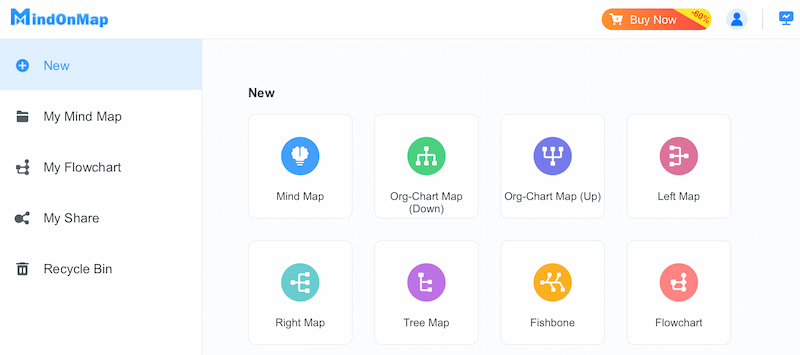
Now, we can enter the working space. Kindly click the Shapes you want and arrange them according to the design you prefer.
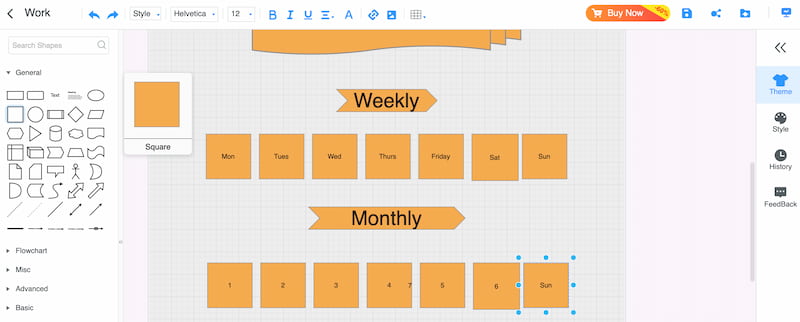
After that, add the label of each shape depending on your working schedule. Then, finalize it by choosing the Styles and Theme before clicking the Save button.
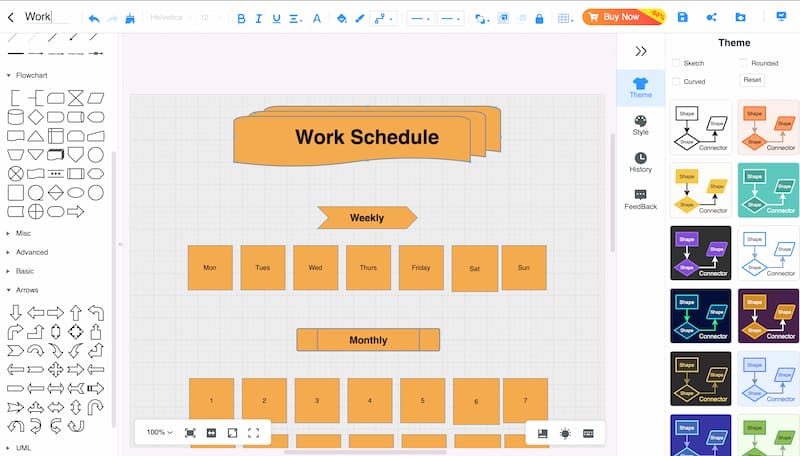
These simple steps can give you a visual of the work schedule. We can now see that the tool is effective and can really help us visualize what we need. If you want, use these templates and edit the work schedule in accordance with your will.
Part 4. Types of Work Schedule
Every firm has distinct requirements, and the nine-to-five schedule is only suitable for some. Businesses that require 24-hour staffing or have other pressing issues to solve frequently use shifts to maximize productivity. The most popular types of workflow schedules are shown below in no particular order:
Dupont Shift Schedule
The Dupont shift schedule is popular among police stations, healthcare facilities, and other 24-hour businesses. This plan has four distinct teams working two 12-hour shifts. Day and night shifts are scheduled on a four-week rotation. Over four weeks, personnel on a Dupont schedule will work as follows.
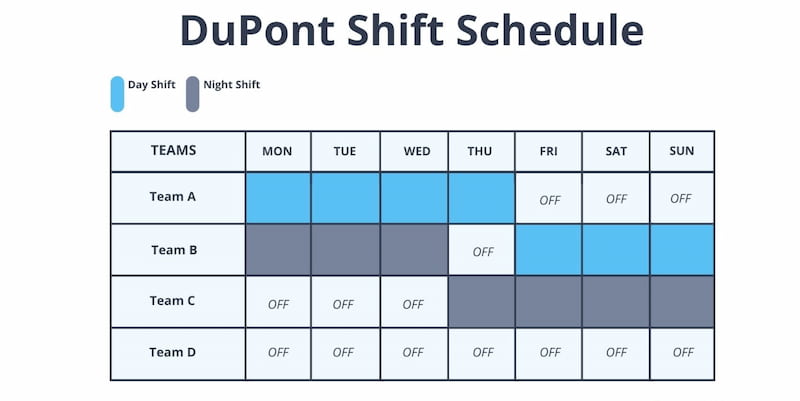
• One day off.
• Three overnight shifts
• Three days off.
• Four overnight shifts
• Three days off.
• Three-day shifts.
• Four-day shifts.
• Seven days off.
2-2-3 Schedule
The 2-2-3 schedule is also a popular choice for sectors that require 24-hour staffing. This system employs a gradual, 28-day rotation cycle, with each employee working 12-hour shifts each day. A typical schedule for four teams goes as follows.
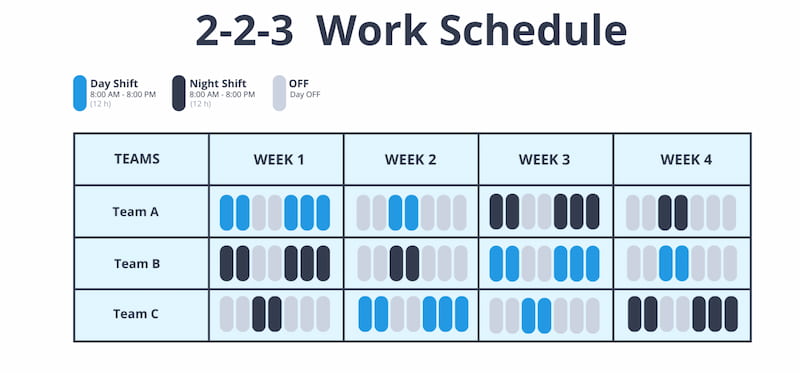
• Two-day shifts.
• Two days off.
• Three-day shifts.
Full-time Work Schedule
A full-time work schedule requires individuals to work between eight and ten hours per day, ranging from the normal 40 to 50 hours per week. Given their lengthy hours, full-time employees typically receive a variety of advantages from their workplace. These frequently include health insurance, sick leave, and retirement plans.
Most full-time schedules include the same shift every day. Shifts vary, but employees often work 34 to 40 hours each week. Non-exempt, full-time employees are paid overtime when they work more than 40 hours. Salaried team members, although earning more money, are excluded from overtime.

Freelance Work Schedule
Contract or freelance workers utilize freelance work schedules. These employees often labor without a predetermined schedule until their projects are completed. In certain cases, governments forbid businesses from directing when or where a freelancer works.
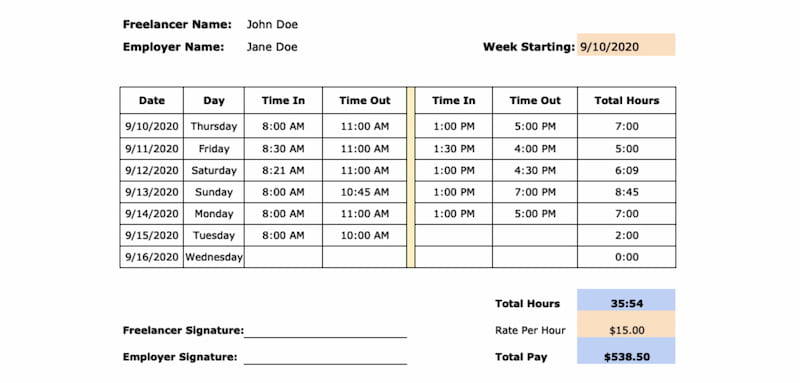
Part-time Work Schedule
Part-time employee work schedules do not meet the location's requirements for a full-time employee. In the United States, employees have 30 or fewer guaranteed hours per week. Their work schedule may occasionally change to incorporate additional or even overtime hours.
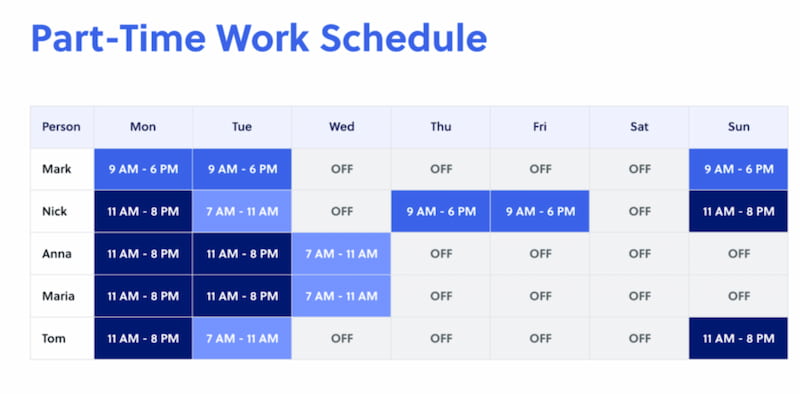
Part 5. FAQs about How to Create Work Schedule
What is the 5 4 9 work schedule?
The 5-4-9 work plan is a two-week compressed schedule in which employees work four 9-hour days and one 8-hour day in the first week, then four 9-hour days and one day off in the second week. This means one extra day off every two weeks.
How do I create a personal work schedule?
To construct a customized work calendar, first identify your duties and priorities. Set your working hours, allot time for each assignment, take regular breaks, and review your schedule on a regular basis to make any necessary adjustments. Calendars and Excel can help you better arrange your schedule.
Does Excel have a work schedule template?
Yes, Excel provides work schedule templates. You can locate these by opening Excel, clicking File, then going to New, and searching for work schedule or weekly schedule. You can alter these templates to meet your work requirements.
What is your regular work schedule?
Full-time employees are most likely to follow the conventional work schedule, which typically runs Monday through Friday from 9 a.m. to 5 p.m. Other common full-time schedules include working 10 hours per day for four days a week or 6.5 hours per day for six days a week.
What is the weekly work schedule?
A weekly work plan allows managers to divide time slots among team members to suit company and employee needs. Some facts to consider while making a weekly schedule are maximum shift length, periods of staff availability, traffic, and workload.
Conclusion
These are the details we need to know about our work schedule. We can see above the essence of it and the best way to create one. That is why we hope the MindOnMap tool can help you with your work schedule.










